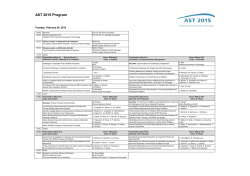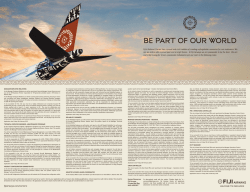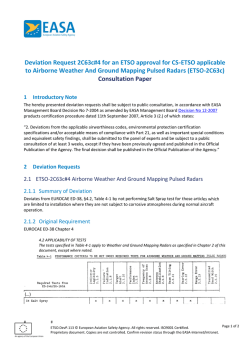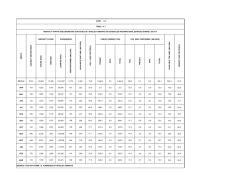
Twenty-seven Minutes Over Ploesti
The B-24s made their bomb run through fire and flak, less than 50 feet above the targets. Twenty-seven Minutes Over Ploesti By John T. Correll Over the Astra Romana refinery, Lt. Robert Sternfels of the 98th Bomb Group lifts the right wing of his aircraft, The Sandman, to clear some tall smokestacks. Turbulence from delayed action bombs, dropped by the previous wave of B-24s, rocks the aircraft. 74 AIR FORCE Magazine / February 2015 G ermany’s greatest vulnerability in World War II was its dependence on foreign oil. The Germans had almost no petroleum resources of their own, and in 1938, imported 72 percent of their gasoline and lubricants. Domestic output accounted for only eight percent. The synthetic fuels industry produced the other 20 percent. One of Adolf Hitler’s motives for invading the Soviet Union in 1941 was to gain the Russian oil fields in the Caucasus Mountains. That failed, and with most of its former sources of oil behind enemy lines, Germany was forced to rely on the oil-rich Balkans, especially Nazi-controlled Romania. A ring of refineries around Ploesti, 35 miles north of Bucharest, supplied about a third of Germany’s gasoline and an even greater share of the high-octane aviation fuel, which was converted from lower-grade fuels by the cracking plants at Ploesti. The importance of Romanian oil was well-understood. In July 1941, the Russians bombed Ploesti, doing considerable damage but with no lasting effect. In July 1942, a dozen US B-24 bombers launched an attack on Ploesti from Egypt. They found the city under heavy cloud cover and dumped their bombs to fall where they might. The only result was to stimulate the Germans to upgrade their defenses. The stage was set for the epic US mission against Ploesti Aug. 1, 1943. It would be one of the most famous air operations in history, but it did not turn out the way the planners imagined. SOAPSUDS Allied leaders decided at the Casablanca Conference in January 1943 that Ploesti should be bombed. For reasons long forgotten, the big mission was known at first as Operation Soapsuds. British Prime Minister Winston Churchill warned that this was “inappropriate for an operation in which so many brave Americans would risk or lose their lives” and that “I do not think it is good for morale to affix disparaging labels to daring feats of arms.” The venture was renamed Tidal Wave. Ploesti was beyond the reach of Allied bombers in England, but B-24s could get there from North Africa. Thus the mission was assigned to the newly organized US Ninth Air Force, which was operating from several bases around Benghazi in Libya. AIR FORCE Magazine / February 2015 The slab-sided, high-winged B-24 Liberator had a greater range and bomb load than the more graceful B-17 Flying Fortress, and a slight advantage in airspeed. For the long trip to Ploesti—1,350 miles each way—extra fuel tanks were installed in the forward section of the bomb bay. Chief planner for the mission was Col. Jacob E. Smart at Army Air Forces headquarters in Washington. The targets were key installations in Ploesti’s nine major refineries—grouped into seven target sets—most of them clustered around the city but one at Campina, about 20 miles to the northwest. The bedrock of AAF doctrine was high-altitude precision bombing with the Norden bombsight, but Smart calculated that it would require at least 1,400 heavy bombers to do the job that way. Including B-24s borrowed from Eighth Air Force in Britain, fewer than 200 would be available. To the horror of traditionalists, Smart concluded that the mission would be flown at low level, with the final bomb run at minimum altitude. Flying low would increase both bombing accuracy and target coverage and also aid in the evading of radar detection. The Norden bombsights were removed and replaced with simple aiming devices. The plan was approved by the Combined Chiefs of Staff and Gen. Dwight D. Eisenhower, Supreme Commander of Allied Forces in North Africa, and was given to Maj. Gen. Lewis H. Brereton, commander of Ninth Air Force, to execute. A full-scale mock-up of Ploesti was built in the desert near Benghazi, where the B-24 crews—two Ninth Air Force bombardment groups and three groups on temporary duty from Eighth Air Force—practiced dropping dummy bombs from low level. Motivation was high, especially after Brereton delivered a ringing exhortation to the crews at a large outdoor meeting where he emphasized the importance of the target. “If you knock it out the way you should, it will probably shorten the war,” he said. “If you do your job right, it is worth it, even if you lose every plane.” Brereton figured he would be leading the mission himself, but AAF Commanding General Henry H. “Hap” Arnold ruled that Brereton would be too valuable to the enemy if shot down and captured. The next-ranking officer, Brig. Gen. Uzal G. Ent, commander of IX Bomber Command, would lead instead. Ent was well-regarded and capable but he was not a B-24 pilot. He would fly the mission from the jump seat of the B-24 Teggie Ann, piloted by Col. Keith Compton, whose 376th Bomb Group would be first in the formation. There was no photoreconnaissance of Ploesti prior to the mission lest the Germans be alerted, so US planners did not know that the defenses had been vastly improved and were now among the strongest in Europe. STRUNG OUT The mission was laid on for a Sunday in order to minimize casualties among the impressed laborers at Ploesti. The aircraft were to maintain radio silence all the way to their targets. As the B-24s rolled out to take off shortly after dawn Aug. 1, tank trucks met them at the end of the runway to top off the fuel in their regular wing tanks and the auxiliary tanks in the bomb bays. One aircraft crashed on takeoff, but 177 launched successfully from their various bases and formed up to cross the Mediterranean. Compton’s 376th Bomb Group led the formation. Behind him, in order, came the 93rd (Lt. Col. Addison E. Baker), the 98th (Col. John R. Kane), the 44th (Col. Leon W. Johnson), and the 389th (Col. Jack W. Wood). An enduring bit of folklore involves the B-24 Wongo Wongo, which spun out of control and fell into the sea near Corfu, off the coast of Greece. Desert Lilly, flying on Wongo’s wing, dropped down—contrary to orders—to check for survivors and could not regain altitude fast enough to rejoin the strike force. According to an oft-told tale, Wongo Wongo and Desert Lilly were the lead and alternate lead aircraft for the mission, and their navigators had been given special maps and briefings not available to the others. This supposedly explains the trouble that ensued later. In fact, Compton’s Teggie Ann was the lead aircraft, and Capt. Harold Wicklund, flying with Compton, was the mission navigator. The two lost aircraft were in the second element of Compton’s group. Of far greater consequence was the feud brewing between Compton and 98th Bomb Group commander Kane, a colorful figure known as “Killer Kane” after a character in the “Buck Rogers” comic strip. Compton and Kane did not like each other. They also disagreed about how to get the most out of the B-24. Compton led the formation at a relatively high speed and expected everyone else to keep up with him. Kane thought 75 As the strike force crossed the border from Bulgaria into Romania, Compton and Baker were 20 minutes ahead of Kane, Johnson, and Wood. With radio silence in effect, Ent and Compton did not order Kane to catch up. Unknown to them, the Germans had intercepted information about the mission and had been tracking the B-24s by radar since they crossed the Mediterranean. The element of surprise was already lost. However, that was not the worst of it. Compton was justified in faulting Staff map by Zaur Eylanbekov it best to save fuel with slower speeds en route and pour on the power as they approached the target. Kane, whose group was third in line, stubbornly flew the mission his way, and a gap developed gradually between the first two groups and the last three. 76 AIR FORCE Magazine / February 2015 Kane for failing to maintain formation integrity, but he was about to make a colossal mistake of his own. WRONG TURN The plan was for all five groups to enter Romanian airspace together, but the formation had already separated into two segments. Ahead lay four initial points: at Pitesti, Targoviste, and Floresti, which were, respectively, 65, 39, and 13 miles from Ploesti. What happened next is the matter of some conjecture. Compton had his own maps and charts and he was consulting them constantly. Teggie Ann passed the first IP at Pitesti flying at about 200 feet, and fast. At that level, the landscape sped by and the hills and rivers all looked pretty much alike. Navigator Wicklund had given Compton an estimated time of arrival for the turning point at Floresti. As the ETA approached, Compton saw a town and landmarks that resembled Floresti and he turned Teggie Ann onto its bomb run. Baker in Hell’s Wench led his 93rd Group southeast, following Compton’s 376th. In fact, the town where Compton had turned was the second IP, Targoviste, not Floresti. It was 39 miles too soon and the two groups were heading directly for Bucharest—headquarters for Romanian defenses—not Ploesti. Aircrews all through the formation saw the mistake immediately, and dozens of them broke radio silence, yelling Above: B-24s practice low-level formation flying against mock targets in the desert near Benghazi, Libya, in July 1943. Left: The route map from Benghazi to Ploesti. AIR FORCE Magazine / February 2015 “Not here!” and “Mistake!” and “This is not it!” Ent and Compton had their radio turned off and did not hear them. Years later, Wicklund said that he had given Compton a wrong ETA and had not corrected him when he made the turn at Targoviste. Baker held formation with Compton but figured out before Compton did that they were on the wrong course and swung the 93rd Group back northward toward Ploesti. A few crews from Compton’s 376th Group went along with Baker. The three groups in the trailing segment of the task force had no way to know that the two groups ahead of them had gone wrong. At Pitesti, Wood, flying as navigator on The Scorpion, split his 389th Group off to the northeast toward the refinery at Campina. Killer Kane in Hail Columbia and Johnson in Suzy Q continued eastward. Their groups, flying the course as briefed, turned onto the assigned bomb run at Floresti. Ent and Compton were near Bucharest before they realized their mistake. With Ent’s concurrence, Compton broke radio silence and instructed all aircraft to turn back toward Ploesti and bomb targets of opportunity. In Ploesti, the Germans were ready and waiting. The town was defended by 237 antiaircraft guns, barrage balloons, flak towers, and hundreds of machine guns. At an air base just to the east were four wings of Bf 109 fighters. Already in motion on a railroad track leading into Ploesti from the north—parallel to the course Kane and Johnson were following—was a flak train with dozens of large-caliber antiaircraft guns mounted on flatcars. THROUGH FIRE AND FLAK The battle plan had fallen apart and the four bomb groups were converging on Ploesti from three different directions, whipping along at 250 miles an hour. They dropped down to less than 50 feet above the ground for the bomb run. The first group to reach Ploesti was Baker’s 93rd and the elements of the 376th that had broken away from Compton. Baker’s assigned target, the Concordia Vega refinery, was now on the opposite side of town, but Astra Romana—the top target of the entire mission—lay dead ahead. It was assigned to Killer Kane’s group, but Baker decided to go for it anyway. Three minutes from target, Baker struck a barrage balloon cable with his wing and Hell’s Wench was hit hard by flak and caught fire. Baker and his copilot, Maj. John Jerstad, ignored an opportunity to belly land with a good chance of survival and led their group onward to the target, where Hell’s Wench crashed and exploded. The flak train, alerted to the attack, was moving at speed when the B-24s arrived, Kane’s group to the right side of the track and Johnson’s to the left. The big guns, some of them 88 mm cannons, opened up at point blank range and the aircraft returned fire with their .50 caliber machine guns. The duel was over in less than 90 seconds. The B-24s managed to riddle the locomotive and stop the train but several aircraft had gone down. 77 Ploesti was an inferno as Kane and Johnson approached. Fires were leaping as high as the wingtips. Thick smoke concealed balloon cables and steeples, and the aircraft were rocked by explosions from delayed-action bombs. They chose to press on with the attack despite the hazards. The official Army Air Forces history said that “B-24s went down like tenpins, but the targets were hit hard and accurately.” B-24s at different altitudes passed over and under each other with scant separation. The Germans were impressed with the complexity and precision of the attack, not understanding that they were watching a spectacular foulup. Compton’s 376th Group, swinging back from Bucharest, had little chance individually and in small formations, evading enemy fighters that pursued them to the Adriatic. “I originally blamed Colonel Kane for not maintaining his position in the formation in accordance with the mission plan,” Compton said years later. “On the return trip to Benghazi I spoke to General Ent and asked him if he were going to initiate court-martial proceedings against Kane for not following orders. His reply to me was, ‘I don’t think we should as we did not stick to the mission plan either.’ ” Six hours out of Benghazi, Ent sent Brereton a two-word message: “Mission successful.” That was true to a considerable extent, despite all of the things that had gone wrong. “The hope for virtually complete destruction of the selected targets with results enduring for a long period of time had been defeated by errors of execution,” the official AAF history said. The destruction would have been greater, of course, if the groups had made their bomb runs together on the right course against the assigned targets, but the planners were unrealistic in expecting one strike to put the Ploesti complex out of business. of finding its target, the big Romana Americana complex on the far side of Ploesti, much less hitting it. Teggie Ann jettisoned bombs and led the way home. However, Maj. Norman Appold and six aircraft from the 376th seized the opportunity to bomb Concordia Vega, which had been the original target for Baker’s group. Meanwhile, Wood’s 389th Group was pounding the Steaua Romana refinery at Campina. It was there that 2nd Lt. Lloyd Hughes, hit several times by ground fire and with sheets of gasoline streaming from his bomb bay and wing tanks, held his course and bombed the target before his aircraft exploded. Twenty-seven minutes had elapsed between the first bombs of the operation, dropped on the edge of Ploesti, and the last ones, which fell on Campina. The surviving aircraft headed south, The raid knocked out, for the time being at least, 46 percent of Ploesti’s oil production and destroyed about 40 percent of the cracking capability. That was a substantial achievement for a 177-airplane operation, especially when compared with results from the 500- and 1,000-bomber missions that came later in the war. The damage was heavy but not permanent. One of the nine refineries was down for the rest of the war, but two others—including Romana Americana— were not bombed at all and continued production. US planners underestimated the maximum effort the Germans, desperate for Ploesti oil, would put into recovery. Facilities that had not been operating at full capacity were activated, and the repair of the major plants was speeded up. They were back on line in a matter of months. Above left: T eggie Ann copilot Capt. Ralph Thompson (l) and Col. Keith Compton (r), 376th Bomb Group commander, help Brig. Gen. Uzal Ent put on the standard flak jacket used by all crew members on the mission. Above: Col. Leon Johnson (l), leading the 44th Bomb Group, and Col. John “Killer” Kane (r), commander of the 98th Group, were 20 minutes behind the lead elements. 7 8 MED AL S OF H ON OR It was almost 10 o’clock that evening before the last returning B-24 landed at Benghazi after 15 hours in the air. Of the 177 bombers that had taken off in the morning, only 92 returned. Fifty- four were lost in the target area, seven set down in Turkey and were interned there, 19 landed at Cyprus and other Allied bases, and the others crashed. Personnel losses were 310 killed, 108 captured, and 78 interned in Turkey. At least 54 of the aircraft that made it back to Benghazi were damaged too badly to ever fly again. Allegations persisted for years that the losses were even worse than announced. In any AIR FORCE Magazine / February 2015 Staff map by Zaur Eylanbekov 389th: Wood 44th: Johnson 98th: Kane 93rd: Baker WRONG TURN AT TARGOVISTE Danube River 376th: Compton event, it was the end of Ninth Air Force as an independent bomber command. What was left of it was transferred to England where it was converted to a tactical air arm to support the D-Day invasion of Europe. Every airman who flew the mission received the Distinguished Flying Cross, and five of them were awarded the Medal of Honor, the most ever presented for a single engagement. Soon after the battle, Kane and Johnson received Medals of Honor for leading their groups through the fire and flak to strike their targets. Shortly thereafter, the Medal was awarded posthumously to Hughes, who had pushed on in his flaming airplane to hit his target at Campina. Baker and Jerstad were also awarded Medals of Honor posthumously—over the objection of some traditionalists in Washington who argued they had disobeyed orders by breaking away from the formation. Eventually, outrage from airmen who had been on the mission overcame the naysayers and the awards were approved. Ent was promoted to major general. Colonel Compton retired in 1969 as a AIR FORCE Magazine / February 2015 lieutenant general and vice commander of Strategic Air Command. Colonels Johnson and Smart became four-star generals and retired in the 1960s. Killer Kane, despite his Medal of Honor, was never promoted again. No plan had been made for follow-on attacks. Allied bombing missions were allocated to strategic targets regarded as being of greater priority and Ploesti went untouched until the late spring of 1944. Gen. Carl A. “Tooey” Spaatz, commander of US Strategic Air Forces in Europe, argued for the continued bombing of German oil assets but the British view, which favored emphasis on marshaling yards and other transportation targets, prevailed. That changed as American influence on Allied strategy increased. In April 1944, Fifteenth Air Force began sustained operations against Ploesti from bases in Italy. Over the next year, Fifteenth Air Force mounted 24 strikes against Ploesti, a total of 5,675 sorties by B-24s, B-17s, and other bombers. Altogether, 254 aircraft were lost on these missions. In addition, allied aircraft struck the German oil infrastructure elsewhere, including the synthetic fuel plants in Germany. “A new era in the air war began,” said German armaments minister Albert Speer. Production from Ploesti was almost ended before Romania surrendered in 1944. By fall, the Luftwaffe was essentially grounded, unable to fly or train for lack of fuel, and the German army was immobile. German armaments production had been brought to a standstill. Ploesti is remembered more for valor than for strategic results. However, the questions remain: What if Operation Tidal Wave had not been beset by the strange combination of mistakes that reduced its results and increased its losses? And what might have been possible if Ploesti had not been a one-shot effort in 1943? ✪ John T. Correll was editor in chief of Air Force Magazine for 18 years and is now a contributor. His most recent article, “The Lingering Story of Agent Orange,” appeared in the January issue. 79
© Copyright 2025







